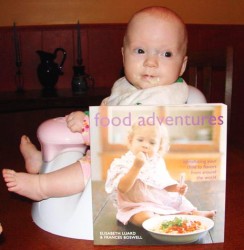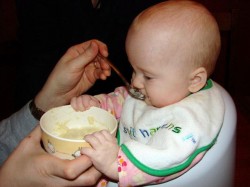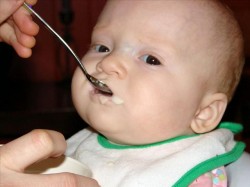Cookbook Review: Food Adventures
Kat is just a few days shy of her six-month birthday, and her new pediatrician, after hearing how the wee tenacious one has been dive-bombing after my toast every morning, has given us the all-clear to start her on solids. In the US, that means giving her rice cereal, which is deemed the most harmless of food substances; in China, many a baby’s first solid food is congee or jook–a porridge made of rice cooked until it falls apart.
So, with a happy heart and light hands, I mixed up a bit of fortified rice cereal with expressed milk and let Zak feed Kat her first solid meal.
While watching Kat learn to take cereal in her mouth, roll it around, taste it and swallow it, it was only natural that I think about what other people from around the world feed their babies when they are ready to start taking nutrition from solid food.
It seems that I am not the first person to think such thoughts; two food writers, a mother-in-law/daughter-in-law team, have also wondered enough about the issue of what babies and children all over the world are fed to actually write a cookbook on the subject.
Food Adventures: Introducing Your Child to Flavors from Around the World by Elizabeth Luard and Frances Boswell can be seen as a reaction to the prevalence of “kids’ food” made especially for and marketed toward children in the United States. With many children eating separate meals from their parents based upon processed foods like macaroni and cheese and chicken nuggets, the authors of Food Adventures are urging parents to avoid the entire idea of children’s food as a separate category and instead give their children a taste of the global kitchen from the beginning.
The very first chapter deals with traditional “first foods’ from various parts of the world, including a chilled Scandinavian blueberry soup, and a leek and potato puree from Belgium. Each recipe comes with a tiny bit of cultural information and recommendations for the proper age to start the child on the food. I was unhappy, however, to see junket–pudding made from whole cow’s milk–suggested for the consumption of six month old babies. The American Academy of Pediatrics recommends no whole cow’s milk for children under the age of one year, because the proteins are not digestible by human infants. In addition, there is too much of some minerals, which can lead to overburdening the kidneys of babies, and of course, there is a risk of inducing a milk allergy if cow milk is given to early to a child.
That is the largest complaint I have with the book; unfortunately, it is fairly significant.
Later chapters, however, are delightfully written. The authors advocate that parents engage children’s senses at the table, teaching them to delight in food that is pleasing to the eye and nose as well as the palate. My favorite chapter is entitled, “Sniff and Seek,” and includes recipes meant to introduce children to the myriad scents that aromatic ingredients such as spices and herbs have to offer. Recipes such as Thai Chicken Rice with Lemongrass and Lime Leaves and nutmeg-scented Swedish Meatballs in Cream Sauce give parents ideas for dishes that are not only delicious but engage a child’s exploration of the olfactory aspects of food and cookery.
Playfulness is encouraged as well, with whimsical recipes like “Cinderella’s Midnight Feast:” a pasta dish that includes ricotta and pumpkin. Role-playing and make-believe, two activities at which children excel are used to help learn manners in a chapter called “The Restaurant Table.” Here the authors shine. Recipes from all over the world are presented along with a discussion of how children are brought to the table in each culture. The proper table manners for each culture are explained, with the suggestion that children playact that they are in restaurant serving these foods at the dinner table, while Mom and Dad model table manners appropriate to the country represented at dinner.
(That is fine and good, though I suspect for younger children the continually changing set of table manners might be a bit confusing. For older kids, however, I think it is a great idea.)
From a parent’s point of view, the recipes look and sound quite tasty. In addition, most of them are fairly simple, with most of the ingredients being easily accessible at well-stocked local grocery stores. The recipes all look easily doable not only by parents for kids, but -with- kids, whether they are underfoot, slung on the back or helping on a stool at the counter. Even the whimsical recipes sound edible to the adult palate; it is only the names and presentation that are playful. The dishes themselves are solid, real food meant for people who like flavors from all over the globe.
I rather enjoyed the book, and I have to admit that Kat likes it, too. From the first time she caught a glimpse of the book, she grabbed it and started cooing and jabbering to the little girl eating spaghetti on the cover. She thoroughly enjoyed leafing through the book, looking at the pictures of the foods, and the kids eating, cooking and playing with them. I look forward to trying out some of the recipes when she is older, though I will stick with her rice cereal for now. (Soon, though, soon, I will be roasting sweet potatoes and mashing them, and pureeing sweet garden peas with mint.)
Bland and typically American as rice cereal is, I have to admit–I added the tiniest pinch of ground cardamom to it before giving it to Kat. It gave the cereal the heavenly scent of kheer–Indian rice pudding–and I cannot help but think it improved the flavor of it immensely. I cannot help but think that the authors of Food Adventures would be pleased.
(Here is a big thank you to Dan Trout for the great photos he took last night of Kat’s first solid meal which are illustrating this post.)
11 Comments
RSS feed for comments on this post.
Sorry, the comment form is closed at this time.
Powered by WordPress. Graphics by Zak Kramer.
Design update by Daniel Trout.
Entries and comments feeds.






I love that last photo. She seems to be eating with gusto, and eying the viewer saying, “what? This is just one good meal of many to come!”
Comment by Diane — March 13, 2007 #
This sounds like a lovely book, I hope people read it and realize that Gerber isn’t the end-all to feeding their child.
I have a huge issue with the way food is marketed to children, or rather, their parents. I hear of so many children that have aversions to food that I can’t help but come to the conclusion that it is because parents are led to believe that only Gerber can feed your child and there is such a thing as “kid food” and parents are given the impression that kids should only be eating mac and cheese and hot dogs while the parents eat their regular meals.
My 17-month old has been exposed to and loves food from a number of cultures. At 3 months he swiped a taste of stir-fry and was in love, at 4 months he was stealing our chicken shawarma from our plates and attempted to stick his head in a very heady lemon and garlic sauce that brought delight to his eyes and he’s been eating Indian dhals and rice since he was 5/6 months old.
Every once in a while he’ll have on off day (usually due to teething), but overall, he loves different foods and I hope it sticks.
On another note, my son is a cinnamon lover. I put cinnamon in his cereal (he liked oatmeal and hated rice), banana, apples and pears. If I fed him bland foods he’d look at me like I lost my mind. Today one of his favorite breakfast items is aloo paratha.
Comment by Jennifer D. — March 14, 2007 #
Sounds like a lovely book! I was adopted at the age of 18 months and when I arrived I ate everything in sight. I don’t know the meaning of finicky. My husband was finicky, though, so we’re wondering which will win out when we have children.
Comment by Kim — March 14, 2007 #
Thanks for this review. My husband and I are adventurous eaters and tried to expose our baby (and later, toddler) twins to all kinds of tastes and textures. They were into it for a while, but got pickier and pickier from age 2 to 3. They are now three and, sadly, eat very little variety. Some kids, I guess, are hard wired that way.
Comment by Beth — March 14, 2007 #
what a great post, and what a darling baby.
Comment by bee — March 14, 2007 #
Foods marketed to children set them up for a lifetime of obesity and the health problems associated with it. Just look at any “kid’s menu” in a given “adult” restaurant, or if you really want to get sick, look at what my school system passes off as “nutritious.” And don’t get me started on the parents who let their kids put ketchup or ranch dressing on everything before they eat it. Ugh.
Comment by artcargirl — March 14, 2007 #
Thanks for the comments, all.
It is a lovely little book; it is a little lighter on the cultural information than I would like, but that is because I am a geek and love to read cookbooks as much as I like to cook from them!
Jennifer, Beth–my first daughter (now 17 years old) started eating Chinese and Thai food very early in life–at a year old or so. She loved them, but then went through a picky phase but grew out of it. Now, she eats and cooks everything, though Indian and Chinese are her favorites.
Artcargirl–I hear you! When is your spring break. I look forward to seeing you if you still want to come visit.
Diane–we have dispensation from the doctor to start her on fruits and veggies, now, too.
Bee–thank you!
Comment by Barbara — March 14, 2007 #
Thanks for pointing us to a book that sounds very interesting. As a French other bringing up two small children in the US I have found myself lost between those different cultural mores, and getting an even wider view of the subject should prove interesting.
But re. your very significant complaint, I think it should be targeted at BabyCenter for publishing a very badly edited article on infant nutrition rather than at the authors of the book.
While cow’s milk proteins are involved in about 25% of infants’ food allergies, it is patently untrue that babies cannot digest those proteins before they are one: formula is heated (breaks down some of the proteins) cow’s milk diluted with water (decreased the load on kidneys) and “enriched” with sugar, vegetable oil and traces of many vitamins and minerals). Most babies (those who are not allergic to the proteins) do fine on it.
What the AAP does recommend against is the use of straight cow’s milk as a substitute for breastmilk or iron-enriched formula before the age of one, at a time when those still make up the bulk of an infant’s nutrition.
http://aappolicy.aappublications.org/cgi/content/full/pediatrics;115/2/496
If you have reached the point when you are comfortable introducing dairy products to your infant’s diet I don’t see how a few milk based puddings for the infant over 6 months old would be a problem.
And finally, I never understood the love of the AAP for iron-enriched rice cereal. It has the taste and consistency of wood glue (and no, I am not fond of congee either). My first son rejected it outright. With my second I only used it as a thickener for soups — at least the vegetables provide some taste…
Comment by Agnès — March 15, 2007 #
Agnes–My understanding of the AAP guidelines on whole cow’s milk comes more from my pediatricians, both for my seventeen year old daughter and the new six-month old one, as well as my readings in various child care manuals, including one published by the AAP. All of these sources have been explicit that whole cow’s milk is best avoided until the child is a year old for various reasons, including the indigestible nature of the proteins, the fact that some of the mineral content is above what many infant systems can handle and the issue of allergens.
My own personal experience with my seventeen-year-old daughter, Morganna, also has led me to be very wary of cow’s milk for infants under one year of age.
I had been told by her pediatrician to completely avoid any cow milk products until she was a year old. She was breast-fed, as is her baby sister Kat, and had been eating solids in the form of rice cereal, fruits and vegetables, for several months when she went out on an outing with my mother when she was about eight months old.
My mother, against my express wishes and directives, gave her a significant amount of soft-serve dairy-based ice cream. Not only did I object to the huge shot of sugar in the ice cream, but the dairy proteins. When my mother brought her home, Morganna was miserable and sick, with a stomach ache that had her arching her back, letting off horrid gas and screaming and writhing in pain.
As the hours went by, nothing made it better and my mother told me that she had given her ice cream–and a significant amount of it. I was floored that she would do this. It turned out that Morganna, who had bowels as regular as clockwork was painfully constipated.
I ended up having to give her a suppository, which was the only time I have had to do such a thing. My mother was there, too, and got to see the pain her handiwork had wrought as Morganna wept in pain for hours until she finally passed a very gassy stool loaded with very solid undigested curds of cow milk.
My father was very unhappy with my mother of the entire incident, and apparently told her to listen to doctors and her daughter from then on, and she was quite contrite. After Morganna was about fourteen months old, she had some ice cream again, and more importantly, some cottage cheese, and she was fine thereafter.
Some kids probably can tolerate cow’s milk earlier than twelve months. But after witnessing the pain and suffering Morganna went through because of it, I would never council anyone to give a baby younger than that any sort of cow’s milk. Goat milk, maybe, but not cow’s milk.
As for the rice cereal–it is because it is the least allergenic of the grains, and it is easily digestible. It doesn’t have much flavor–hence my addition of the breast milk and cardamom to give it a sort of kheer-like taste. I have also taken to adding brown rice farina to it–basically ground brown rice that I have to actually cook instead of just mixing into an instant mush–because it has more fiber, which helps avoid constipation and gives it more flavor, to boot.
Other than the cereal, I am avoiding packaged baby foods altogether. I don’t think they taste good, nor do I think that they have much in the way of vitamins, because they are cooked to such a high heat in the canning process. But this is fodder for another post, soon to come up…..
Comment by Barbara — March 17, 2007 #
I was a big baby, (still am, according to some folks, my wife included.)
I was allergic to breast milk when I was born, (the first of many MANY allergies. Food allergies, I am fortunate enough to have totally outgrown, pollen, mold, and dander however…)
I was on solid food from the time I came home. Doctor’s orders. Rice and Bananas.
Part of the reason I was so big is that by all calculations, Mom’s pregnancy was about 10 months. There’s a food related joke that goes with that…
Mom’s major craving during her pregnancy with me, (and from my understanding, my brother as well,) was steak and baked potatoes, (one of my favorite’s growing up. I still would wade through hell for a good steak.) Mom still says that I didn’t want to come out because I wouldn’t get steak again until I had teeth.
And a big “You’re Welcome” for the pictures. My pleasure. It was awesome being there to see the Katster get her first solid food!
-D
Comment by Dan — March 18, 2007 #
Posting rather late here…
For a very long time I searched for the reason why babies shouldn’t have cow’s milk. There are so many unfounded old wives tales about what rug rats should and should not eat that I didn’t want to take any on faith. I learned that early introduction of cow’s milk is associated with increased chance of allergies, so I was reasonably satisfied.
Then I started reading Harold McGee’s updated “On Food and Cooking.” In it he points out that babies’ digestive systems aren’t fully functional for about a year. As a result, milk isn’t fully digested and large molecules make their way to the lower intestine, from whence they are absorbed into the blood stream. The immune system doesn’t recognize large milk molecules as safe and attack them, and are sensitized to continue to attack them. Ergo the allergies. I am now very satisfied and would not feed cow’s milk to a sub-one-year-old, even if he didn’t evidence the discomforts that Morganna did.
Comment by Harry — October 11, 2007 #